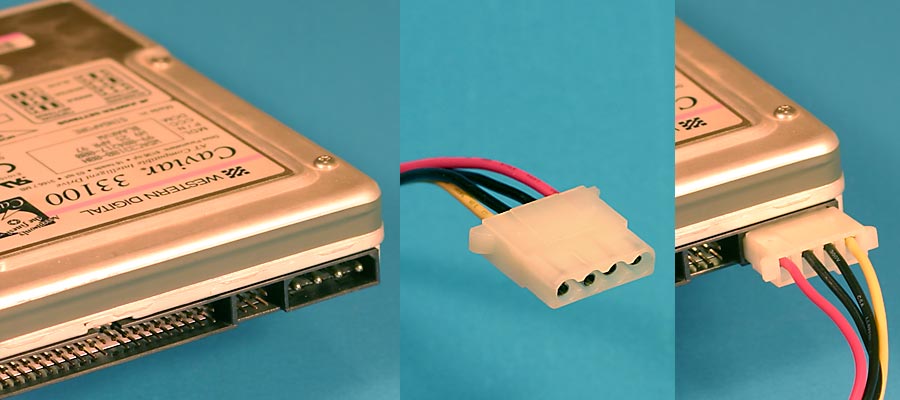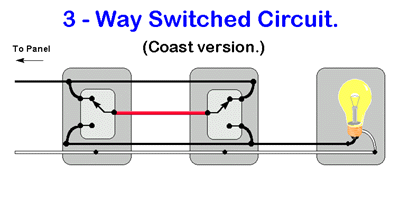
Wire diameter is specified in AWG number (American Wire Guage) which is a stupid and overly complex system. Of course. "By definition, No. 36 AWG is 0.005 inches in diameter, and No. 0000 is 0.46 inches in diameter. The ratio of these diameters is 1:92, and there are 40 gauge sizes from No. 36 to No. 0000, or 39 steps. Because each successive gauge number increases cross sectional area by a constant multiple, diameters vary geometrically. "^ So the diameter of wire of AWG guage n is 0.005 * 92 ^ ((36 - n) / 39) inches or 0.127 * 92 ^ ((36 - n) / 39) mm. Except... for AWG sizes larger than 0 which are

The four pin peripheral power cable dates back to the original PC. It was used for floppy drives and hard disks. It's still around and is now also used for all kinds of things including add-on fans, extra video card power, supplemental motherboard power, and case lighting. It's as old as the hills but is still very widely used. The connector is shaped so that it only fits in one way. You don't have to worry about inserting it the wrong way. People often use the term "4 pin Molex power cable" or "4 pin Molex" to refer to a four pin peripheral power cable. It's not a technically useful term because the 4 pin 12 volt cable is also a 4 pin Molex cable (Molex makes lots of connectors) but "4 pin Molex" is commonly used to refer to peripheral cables anyway.
| Pinout | ||
|---|---|---|
| Pin number | Wire color | Description |
| 1 | yellow | +12 volts |
| 2 | black | ground |
| 3 | black | ground |
| 4 | red | +5 volts |
| Connector part numbers | ||||
|---|---|---|---|---|
| Socket housing | Socket | Pin housing | Pin | Maximum current per circuit |
| AMP 1-480424-0 | AMP 60619-1 | AMP 1-480426-0 | AMP 60620-1 | 13 amps |
I don't know of any official definition of the maximum current allowed in a peripheral cable. The connector can handle 13 amps according to the manufacturer. But you normally find 18 awg wire in the peripheral cables. If you have an 18 inch cable (about a half a meter) and are running 13 amps through 18 gauge wire then you get a voltage drop of about 0.25 volts counting both the power wire and the ground (it's got to go both ways) and the dissipation is about 3.3 watts. That's not good. I've just played it safe and listed the maximum current as 5 amps.
| Unofficial cable/connector maximum wattage delivery | |||
|---|---|---|---|
| Voltage rail | Number of lines | Maximum current | Maximum wattage |
| +5 volts | 1 | 5 amps | 25 watts |
| +12 volts | 1 | 5 amps | 60 watts |
Current power supplies usually have at least two separate peripheral power cables, each of which has two or more peripheral connectors. When you're plugging in multiple high powered devices it's a good idea to spread the load between all of your cables. Don't just plug all your devices into one cable unless they're relatively low load devices. Spreading the current between the cables reduces the voltage drops and power loss. If they're relatively low current devices like fans or it's just a disk drive or two then it doesn't really matter. But if you're putting lots of hard disks into a computer (some can draw almost 3 amps at 12 volts when doing some operations) or connecting a video card's auxiliary power, then spread the loads between the peripheral power cables. It's also helpful if you use a connector as close to the PSU as possible rather than sticking things at the end of the cable. Extra wire just means more voltage drop. And if you're using a peripheral connector to PCI Express adapter then be sure to plug each of the adapter's peripheral connectors into a separate PSU cable. They gave you two peripheral connectors for a reason. Plugging them both into the same PSU cable forces your video card to draw its 12 volt power through one 18 gauge wire. That increases your voltage drop and power dissipation in the cable. Some current high-end video cards can suck up more than 10 amps at 12 volts with most of it coming through the PCI Express connector so it pays to be careful. It will probably work if you don't spread the load but there's no excuse for not doing it properly. They gave you multiple cables. You might as well use them. Plus there's just something creepy about having warm wires even if they're not melting.
You will occasionally run into peripheral connectors which don't have all four wires. They are usually 12 volt only cables intended for fans. Never plug one of those into a disk drive. Drives expect both 5 and 12 volts to be provided. Some of the two-wire peripheral connectors are for speed-controlled fans. That means that the voltage changes depending on the desired fan speed. The connector will only provide 12 volts when the fan is going full speed and the voltage decreases to slow the fan down. Definitely don't plug that one into anything but a fan! Normally this kind of peripheral connector has "fan" printed on it to warn you. As long as a peripheral connector has four wires: one yellow, two black, and one red and it doesn't have some kind of printed warning attached then it's a standard peripheral cable and you can plug it into anything.



With reguard to wireing in the home:
Thermostat circuits are generally Class 2 power limited circuits as defined in NEC article 725. They must be wired with UL listed cable labeled "CL2". Category 5 network cable is usually listed as type "CM" (article 800) but some styles may be dual labeled as "CL2" also. If you're careful to buy the right cable, article 725 (remote control) circuits can be run in the same cable with article 800 (communication) circuits. There are fixed legal limits on the power (not just voltage) that these circuits can supply (think fuses). Read and understand the NEC before doing any wiring in your house. This kind of wiring can burn down houses if done wrong.
Questions:
| file: /Techref/wireing.htm, 10KB, , updated: 2018/3/15 17:30, local time: 2025/10/9 14:49,
216.73.216.152,10-1-189-50:LOG IN
|
| ©2025 These pages are served without commercial sponsorship. (No popup ads, etc...).Bandwidth abuse increases hosting cost forcing sponsorship or shutdown. This server aggressively defends against automated copying for any reason including offline viewing, duplication, etc... Please respect this requirement and DO NOT RIP THIS SITE. Questions? <A HREF="http://www.piclist.com/tecHREF/wireing.htm"> Wiring</A> |
| Did you find what you needed? |
|
o List host: MIT, Site host massmind.org, Top posters @none found - Page Editors: James Newton, David Cary, and YOU! * Roman Black of Black Robotics donates from sales of Linistep stepper controller kits. * Ashley Roll of Digital Nemesis donates from sales of RCL-1 RS232 to TTL converters. * Monthly Subscribers: Gregg Rew. on-going support is MOST appreciated! * Contributors: Richard Seriani, Sr. |
|
The Backwoods Guide to Computer Lingo |
.